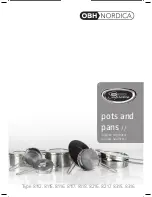
14
HOOD
420
Min.
min.
650
mm. with hood
min.
700
mm. without hood
mm.
600
Min.
mm.
420
Min.
mm.
HOOD
900
Min.
mm.
420
Min.
min.
650
mm. with hood
min.
700
mm. without hood
mm.
420
Min.
mm.
Fig. C
Fig. D
Making the Gas Connection
The appliance should be connected to the mains or to a gas
cylinder in compliance with current National Regulations.
Before making the connection, check that the cooker is regu-
lated for the gas supply you are using. If not, follow the in-
structions indicated in the paragraph “Converting to Different
Types of Gas."
O
n some models the gas supply can be con-
nected on the left or on the right, as necessary; to change
the connection, reverse the position of the hose holder with
that of the cap and replace the gasket (supplied with the
appliance). When using liquid gas from a cylinder, install a
pressure regulator which complies with the current National
Regulations.
Important:
Check that the supply pressure complies with
the values indicated in table 1 “Burner and Nozzle Character-
istics” since this will ensure safe operation, correct consump-
tion and ensure a longer life for your appliance.
Connection with a Hose
Make the connection using a gas hose that complies with
requirements set forth by the current National Regulations.
The inner diameters of the pipe are as follows:
- 8 mm for liquid gas;
- 13 mm for methane.
When installing the hose, remember to take the following
precautions:
•
No part of the hose must come into contact with parts
whose temperature exceeds 50°C;
•
The length of the hose should be less than 1500 mm;
•
The hose should not be subject to twisting or pulling, and
should not have bends or kinks;
•
The hose should not touch objects with sharp edges,
corners or moving parts, and it should not be crushed;
•
The full length of the hose should be easy to inspect in
order to check its condition.
Check that the hose fits firmly into place at the two ends and
fix it with clamps complying with current National Regula-
tions. If any of the above recommendations can not be fol-
lowed, flexible metal pipes should be used. If the cooker is
installed in compliance with the requirements for class 2,
subclass 1, it is highly recommended that the gas con-
nection be made with a flexible metal pipe in compliance
with current safety standards.
Connecting a Flexible, Jointless, Stainless Steel Pipe
to a Threaded Attachment
Remove the hose holder fitted on the appliance. The gas
supply pipe fitting is a threaded 1/2 gas cylindrical male at-
tachment. Use only pipes and seals that comply with current
National Regulations. The full length of the pipe when in-
stalled must not exceed 2000 mm.
Checking the Seal
Important:
O
nce the installation has been completed, check
to make sure that the seals on all the connections are tight,
using a soapy solution (never a flame). After the connection
has been made, make sure that the flexible metal pipe does
not come into contact with moveable parts and that it is not
crushed.
Connecting the Power Supply Cord to the Mains
Install a normalised plug corresponding to the load indicated
on the data plate. When connecting the cable directly to the
mains, install an omnipolar circuit-breaker with a minimum
contact opening of 3 mm between the appliance and the mains.
The omnipolar circuit breaker should be sized according to
the load and should comply with current regulations (the earth
wire should not be interrupted by the circuit breaker). The
supply cable should be positioned so that it does not reach a
temperature of more than 50°C with respect to the room tem-
perature, along its length. Before making the connection,
check that:
•
The limiter valve and the home system can support the
appliance load (see data plate);
•
The mains are properly earthed in compliance with cur-
rent safety standards and regulations;
•
There is easy access to the socket and omnipolar circuit
breaker, once the hob has been installed.
N.B.:
Never use reducers, adaptors or shunts since they can
cause heating or burning.
Converting the Cooker to Different Types of Gas
In order to convert the cooker for use with a type of gas
different than the one for which it was factory set (indicated
on the label attached to the lid), the following steps must be
taken:
a)
Replace the hose holder mounted on the appliance with
that supplied in the bag of “cooker accessories.”
Important:
The hose holder for liquid gas is marked 8, the
hose holder for methane and city gas is marked 13. In any
case, always use a new sealing gasket.
b)
Replace the burner nozzles on the hob:
•
Remove the grids and slide the burners from their housings;
•
Unscrew the nozzles using a 7 mm socket spanner, and
replace them with nozzles for the new type of gas (see
table 1 “Burner and Nozzle Characteristics”).
•
Replace all the components by repeating the steps in
reverse order.
c)
Minimum regulation of the hob burners:
Summary of Contents for K6G11S/I
Page 1: ...Cucina Installazione e uso Cooker Installation and use K6G11S I...
Page 21: ...21...
Page 22: ...22...
Page 23: ...23...










































